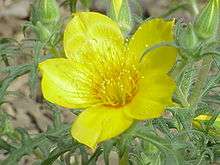Mentzelia pumila
Mentzelia pumila, (dwarf mentzelia, desert blazing star, blazing star, bullet stickleaf, golden blazing star,[1] yellow mentzelia, evening star, moonflower, Wyoming stickleaf,[1] etc.) is a biennial wildflower found in the western United States and northwestern Mexico from Montana and North Dakota, south to Sonora and Chihuahua. It is a blazingstar and a member of the genus Mentzelia, the stickleafs; member species are also called "evening stars", but some stickleafs close at sunset, as does M. pumila.
| Mentzelia pumila | |
|---|---|
 | |
| Scientific classification | |
| Kingdom: | Plantae |
| Clade: | Tracheophytes |
| Clade: | Angiosperms |
| Clade: | Eudicots |
| Clade: | Asterids |
| Order: | Cornales |
| Family: | Loasaceae |
| Genus: | Mentzelia |
| Species: | M. pumila |
| Binomial name | |
| Mentzelia pumila | |
Leaves of Mentzelia pumila are long, very narrow, and serrated-pinnate-like; also medium to light grayish green; an individual plant in an opportune site can be 1.5–2.5 feet (1 m) in height. The flowers are a bright, glossy medium yellow, and the major petals are variable, sometimes 5 major, 5 minor; also 4 and 4.
Mentzelia pumila is covered in minute elaborations known as trichomes, which pierce and trap insects that land on it. A species of aphid, Macrosyphum mentzeliae colonises the plant and is afforded protection, since its main predator, the ladybird beetle, is unable to avoid the trichomes.[2]
Uses
The root is a laxative.[3] The Zuni people insert this plant into the rectum as a suppository for constipation.[4] The plant is also used to whip children to make them strong so they could hold on to a horse without falling.[5]
Footnotes
- "Mentzelia pumila". Germplasm Resources Information Network (GRIN). Agricultural Research Service (ARS), United States Department of Agriculture (USDA). Retrieved 5 September 2014.
- Eisner, Thomas (2003). For Love of Insects. Harvard University Press. pp. 299–304. ISBN 978-0-674-01827-3.
- "Mentzelia pumila - (Nutt.)Torr.&A.Gray.;". Archived from the original on January 17, 2009. Retrieved February 18, 2010.
- Stevenson, Matilda Coxe 1915 Ethnobotany of the Zuni Indians. SI-BAE Annual Report #30 (p. 57)
- Stevenson, p.84
References
External links
- Photo-Medium Res--(NOTE: 5-1/2 major petals, 5 minor-(a VARIATION)); Article – www.saguaro-juniper.com – "Wildflowers on Saguaro-Juniper Lands"
- Photo-High Res--(Field Photo); Photo-(Flower-(and Seed pod)--Very High Res); Article – www.naturesongs.com – "Verde Valley-(Arizona) Plants"